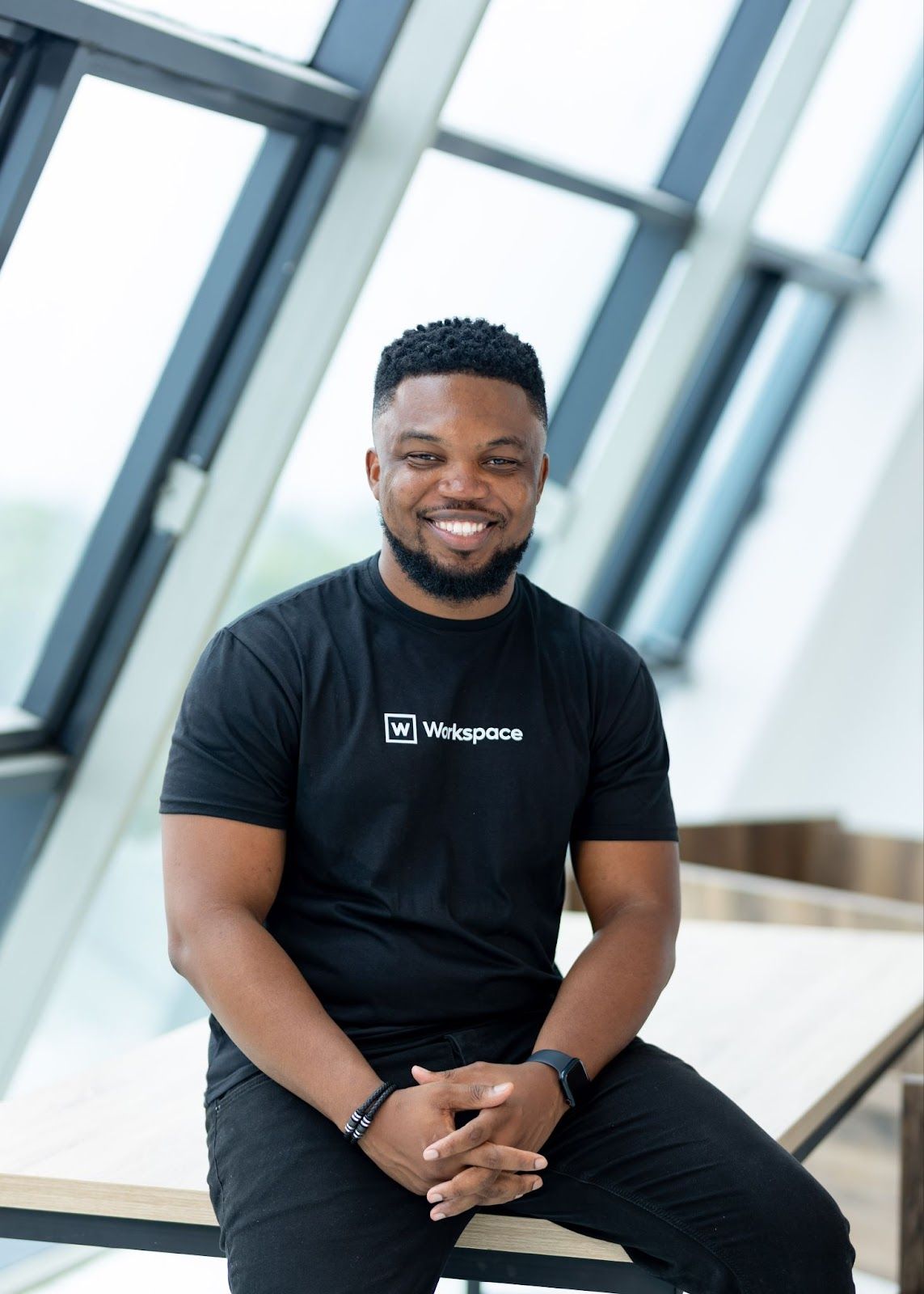Workspace is where creative work gets done. It's a design service that provides you with instant access to unlimited design services on-demand to grow your brand. Before Workspace, the founder, Sydney Sam, a member of the 2019 Forbes Africa 30 Under 30 cohort, ran Moonlight Cafe, a stand-up comedy, live music, and spoken word platform that toured university campuses in Ghana. Notable names such as Mr. Eazi and Kidi have emerged from that platform. Unfortunately, it did not scale, which led to the birth of the Workspace Global platform, focused on giving businesses the support they need to grow and stay competitive.

The Birth of Workspace
Sydney realized that one of their struggles running Moonlight Cafe was brand partnerships. He personally struggled to position the brand in a way where sponsors would want to work with them. He started to invest time in understanding branding and design and eventually became a freelancer, providing branding and design support services for businesses. This offered him a first-hand understanding of the brand needs of African creatives and young entrepreneurs.
Sydney: So I started to invest my time in understanding what that whole thing was. What was branding? What was design? In some cases, I learned design myself, not from a talent and art perspective, but rather to solve the problems of an entrepreneur. We had a very unique, or I had a unique way of approaching designing brand assets, designing corporate profiles, designing websites, etc. So, one thing led to the other, and I started supporting young entrepreneurs at the time with their designs and branding needs. Now, I did that technically as a freelancer for a little bit of time, where I also really learned and understood firsthand the issues that freelancers or African creatives would face in terms of finding customers, managing customers, project management, you know all those things.
Pivoting to a new model
Workspace began as a creative studio and agency, earning Sydney recognition in the 2019 Forbes 30 Under 30 cohort. However, this model constrained the impact Workspace aimed to achieve. With a goal of impacting thousands of global business & African creatives, Sydney and his team restructured from a traditional agency model to an innovative tech platform, integrating AI and software to streamline design workflows at scale.
Sydney: My team and I got to thinking about remodelling and pivoting our entire business to what it is today, which is the Workspace Global platform. Essentially, we invest heavily in the design workflow to ensure that it is easy and accessible for any business to access the brand support they need, or for any creative in Africa who can contribute to design or the creative business space to access remote, flexible work opportunities. By using software AI in our innovative business model, we have been able to build this platform, and it has started to create a massive impact in the ecosystem.

Going from Zero to One: The Workspace MVP
Workspace created a simple equation to enable them to move from ideation to launching the initial version of the product. This process involved reverse-engineering the service delivery process to optimize it for efficiency and effectiveness.
Sydney: In building our business, I knew we needed a way to streamline everything. So, we started with a core question: how could we deliver a complete service, from understanding customer needs to final delivery, within 24 hours? This ambitious goal became our guiding equation. It was a tough challenge, but it forced us to break down our entire business model into manageable steps focused on speeding things up.
Here's where we saw the biggest opportunities:
- Onboarding and Commissioning Work: Traditionally, onboarding agencies take weeks! Proposals, invoices, back-and-forth communication – it's a slow process. In our Workspace, we cut that down to 30 seconds!
- Customer Communication: Sharing a vision often takes days, even weeks, for large companies. We knew this had to change. With Workspace, customers can express their vision in just 7 minutes!
- Talent Pool: Guaranteeing readily available talent is crucial for fast delivery. We developed a system to ensure this, but that's a story for another time.
Now, the key thing to remember is that we didn't have the resources to build everything custom from the start. So, we got creative! We used existing third-party software to create a Minimum Viable Product (MVP) and test our core concepts. This was a smart move. It allowed us to validate our ideas with real users before investing heavily in custom development. Now, based on the validated needs we identified, we're building our own proprietary software.
My key takeaways from this process are: Start with a clear equation for your value proposition; break down your model and identify areas for innovation; utilize existing third-party tools to test and validate your model before building custom solutions; continuously test and refine your approach based on market feedback.
By following these steps, you can simplify your business model, get to market faster, and achieve greater success!
Going to Market
Once the initial version of the platform was ready for the market, Workspace took it to market through testing with its existing clients, leveraging brand support programs, and his personal brand.
Sydney: Well, the good thing about Workspace is that we had an existing clientele for over 9 years that we began, so we started to test it with them with existing customers to say hey! This is a new way to work with us. So they were like technically our guinea pigs, but also, you know generally, they have used the platform giving us good feedback and the things that we are using to market those things. The second thing was mainly with my personal brand. I do a lot of impact work public speaking, you know, in the market, so I use that as a platform to introduce the business. So that has also been a very nice organic way to get people’s attention to get people trying that out. The third thing we are doing, we are going through partnership, so we are in the midst of a big partnership campaign right now, where we are attracting ecosystem players, hubs, you know, accelerators so that we can run what we are calling our brand accelerator with them, so it is like a series of educative instrument and then offering a counted branding services to their communities right. So that is what we are doing and then how we are driving adoption this year and then eventually, we will start doing like hardcore and global marketing and sales activity.
The Journey So Far
The design subscription game in Africa is new, and as one of the first movers in the space, Workspace has launched a design subscription feature that challenges the likes of Superside, Design Pickle, and Penji. Workspace had to do extra work to get their users or clients to adopt this new way of accessing brand support. For users, it means switching from the traditional agency models and DIY platforms like Canva and Wix. They have since been able to serve a local and global clientele in Ghana, Nigeria, Kenya, Senegal, South Africa, Sudan, Rwanda, the UK, USA, China, and Germany and aim to take over the rest of the world.

Sydney: We had a great advantage launching Workspace 2.0 – an existing clientele for over 9 years! This gave us a fantastic pool of familiar faces to test the platform with. We reached out to them and said, "Hey! We have this new way to work with us – check it out!" They essentially became our beta testers, but also valuable early adopters who provided great feedback that helped us refine the platform. Their positive experiences became a key part of our initial marketing efforts. In addition to leveraging my existing client base, I also used my personal brand as a springboard. As you know, I'm heavily involved in public speaking and impact work. These platforms gave me a natural opportunity to introduce Workspace to a wider audience. It's been a great way to organically generate interest and get people to try out the platform. The third prong of our strategy focuses on partnerships. Right now, we're in the midst of a major partnership campaign. We're targeting ecosystem players like hubs and accelerators to collaborate with. Together, we'll be running what we call our "Brand Accelerator" program – a series of educational tools and discounted branding services offered to their communities. This multi-pronged approach is how we're driving adoption for Workspace this year. Once we have a solid user base established, we'll shift gears and launch more traditional, large-scale marketing and sales activities.
Lessons Learned & Gems for Founders
Sydney has picked up valuable lessons from his entrepreneurial journey, and he has these gems for founders and aspiring entrepreneurs.
Sydney: I've learned a few key lessons the hard way. Let me share three important things I keep in mind:
- Product-Market Fit is King: Don't fall in love with your own idea for so long that you ignore the market. The market is constantly changing, and you need to listen to what people actually want, how they want it, and how much they're willing to pay for it. These three factors will guide your product development and investment decisions.
- Check Your Ego at the Door: As an entrepreneur, it's easy to get caught up in the allure of being a "startup founder." But remember, your ego shouldn't drive the business. Many founders struggle because they can't see their own toxic traits that are harming the company. Honest self-reflection is crucial to identify and address any areas where you might be hindering growth.
- Embrace Resourcefulness: Don't feel pressured to build everything from scratch! Many things can be done cheaply or for free. Start by testing your concept with readily available resources, like free online tools. You might be surprised how far you can get with minimal upfront investment. Remember, focus on user testing and iterate based on their feedback. There's a good chance you might not even need custom software if an existing solution already meets your customers' needs.


